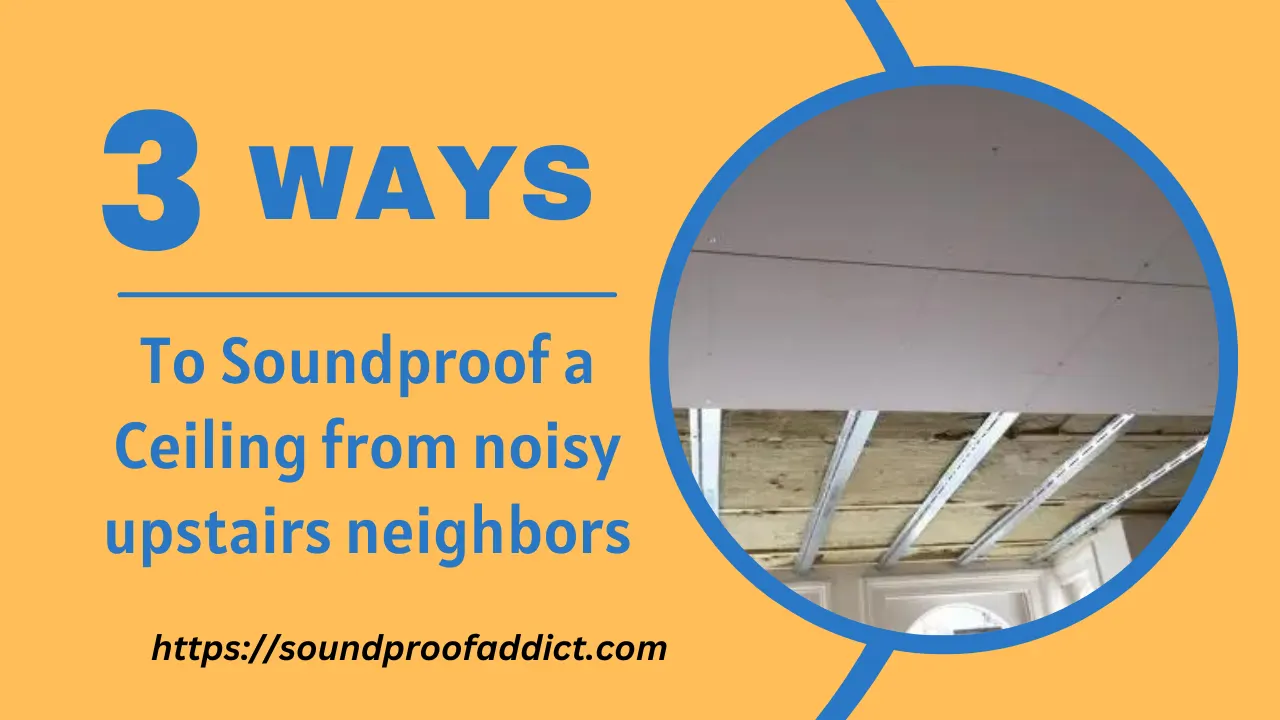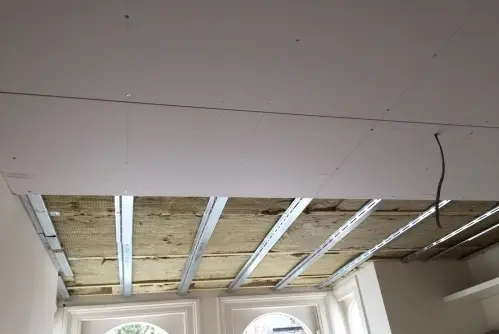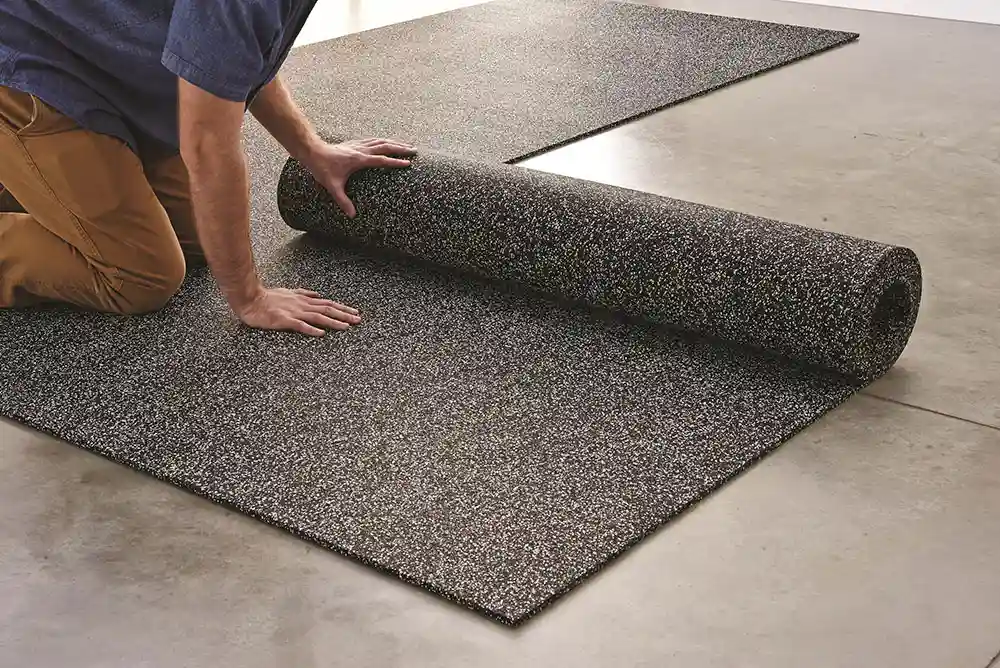How To Soundproof a Ceiling From Noisy Upstairs?

Noisy upstairs neighbors can be a real headache, they can literally ruin your peace and distract you from your work that you don’t want to.
This is something that had happened to me a lot until I took the steps to soundproof my ceiling especially to deal with the noisy upstairs neighbors.
Now, my ceiling is so soundproof that sometimes I even forget that there are people living above me.
So if you want to make your ceiling something like this then stay till to the end. In today’s guide, I’m about to give you 3 proven ways to soundproof a ceiling from noisy upstairs neighbors.
It is time to get into the details.
3 proven ways to soundproof a ceiling from noisy neighbors
1: Use a combination of Mass-loaded vinyl with drywall sheets
Using a combination of Mass-Loaded Vinyl (MLV) with drywall sheets is an effective method for soundproofing a ceiling against noise from upstairs neighbors.
This is one of the best way to soundproof a ceiling from noisy upstairs neighbors. This approach adds mass and sound-dampening properties to the ceiling, which is what is required to reduce sound transmission.
Mass-loaded vinyl and drywall are two well-known and really effective soundproofing materials. One is like Iron man and another is like Captain America. When combined, they create a powerful soundproof barrier.
The MLV layer is applied first, and the drywall is then added on top. Okay, here is how you can use this option to make your ceiling effective at blocking noise from upstairs.
Materials you’ll need in the process:
- Mass-Loaded Vinyl (MLV) sheets
- Drywall sheets
- Drywall screws
- Screwdriver or drill
- Measuring tape
- Utility knife
- Safety gear (gloves, safety glasses, mask)
Steps:
#1: Use your measuring tape to figure out the size of the ceiling you are going to soundproof.
#2: Cut the MLV sheets to match the size of your ceiling. A utility knife works well for this.
#3: Place the MLV sheets against the ceiling, make sure they’re flat and then staple it to the joist.
#4: Now, measure and cut the drywall sheets to match the ceiling area. This will be the layer that covers the MLV. You will need more than just one drywall so you really need to be precise in your measurement and cutting.
#5: And with the help of a drywall lift or with someone’s help, lift the drywall to the ceiling and by using one and half (1½) inch drywall screws, screw the drywall sheets onto the MLV-covered ceiling.
#6: To make it look nice, you can tape over the seams and screw holes in the drywall. After all this hard work, you should notice a significant reduction in the noise coming from upstairs.
So this is how you can soundproof your ceiling to prevent sound from upstairs by using a combination of Mass-loaded vinyl with drywall sheets.
This method is highly effective, but it can be a bit pricey. For a standard-sized room ceiling, you can expect to spend around $500, but the final cost will vary depending on the size of your ceiling.
Related: How to soundproof a suspended ceiling?
2: Use acoustic mineral wool insulation (for timber joist ceiling)

Soundproofing a timber joist ceiling using acoustic mineral wool insulation is an effective method for timber joist ceiling soundproofing to reduce impact noises from upstairs neighbors.
Acoustic mineral wool insulation is a dense and sound-absorbing material that helps dampen sound waves very effectively.
When applied to a timber joist ceiling, it reduces airborne and impact noise by absorbing sound and preventing it from traveling through the structure. This method is suitable for both new construction and retrofitting existing ceilings.
Here’s the game plan:
#1: Put on your safety gear: gloves, safety glasses, and a mask. Safety isn’t just important; it’s absolutely crucial while working with acoustic mineral wool insulation.
#2: Take a proper measurement of spaces between the timber joists and purchase the appropriate amount of acoustic mineral wool insulation.
#3: Cut the insulation batts to the correct size to fit snugly between the joists, it it inherently fit properly between the joists then bring a smile on your face and insert the insulation between the joists by making sure it fits tightly and covers the entire ceiling area.
#4: you removed any ceiling material earlier in the process, now’s the time to replace it. And with that, you’re pretty much done!
This method of soundproofing the ceiling is not that expensive. According to angi.com, rockwool insulation costs about $0.62 per square foot. This means you’d spend less than $50 for a single layer insulation and up to $100 for double layers acoustic mineral wool insulation for a standard-sized ceiling.
However, if you are not fully satisfied with its result then consider attaching a layer of drywall over the mineral wool insulation using drywall screws. Drywall is extremely effective, and once you’ve attached it over the mineral wool, I can’t imagine you’ll still be unhappy.
By the way, I do let you know that this is the same technique I have used to soundproof my ceiling to get rid of noise from upstairs.

But I went the extra mile and added a layer of mass loaded vinyl between the mineral wool insulation and the drywall sheets. And this process has cost me over $1000 for my ceiling, but to be honest, I literally feel like there’s no one living above me at all.
Related: Breaking Down the Expenses: Ceiling Soundproofing Costs
3: Carpet or Underlayment on the Upper Floor:

Installing carpet or an acoustic underlayment on the upper floor is a practical and budget-friendly solution for soundproofing your ceiling and reducing noise from upstairs neighbors, especially when it comes to impact noise like footsteps and dropped objects. It is the best way to soundproof a condo ceiling.
To use this method, you’ll need to encourage your upstairs neighbors to consider adding carpeting or an acoustic underlayment to their floors. However, this can be a challenge, especially if your neighbors aren’t cooperative.
If you find yourself in this situation, try having a polite conversation with them. Explain the noise issue, and offer to help cover the cost of the carpet or underlayment. If your upstairs neighbors are understanding, there’s a good chance they’ll be willing to cooperate.
Carpet prices can vary from $30 to $100, while acoustic underlayment prices can range from $50 to as much as $200 for a high-quality underlayment.
However, if you notice that the noise coming from upstairs are machinery noises then ask them to use anti-vibration mats or pads beneath the noisy appliances and prevent the vibration traveling down.
Related: How to make a basement ceiling soundproof?
How to soundproof timber joisted ceilings from noisy upstairs neighbors?
To soundproof timber joisted ceilings from noisy upstairs neighbors, you can use acoustic mineral wool insulation. Just determine how much mineral wool insulation you would need and fill the joist with it.
This option is super affordable but adding just a single layer of mineral wool might not give you the result you are aiming for.
So for the best result, try adding another layer of mineral wool insulation or as an alternative you attach a layer of drywall over the insulation.
Both methods are quite effective; the main difference is that adding drywall will give you a more finished look.
So in my opinion, using acoustic mineral wool insulation with drywall is a solid choice for soundproofing timber joisted ceilings.
How to soundproof a concrete ceiling from noisy upstairs?
To soundproof a concrete ceiling from noisy upstairs neighbors, I would recommend attaching a layer of mass-loaded vinyl (MLV) and drywall sheet. To use this technique:
- Use a stud finder to locate the ceiling joists. Mark their positions with a pencil.
- Measure the dimensions of the ceiling, and then cut the MLV sheets to fit.
- Also, cut the drywall sheets to size using a utility knife. You may need more than one drywall, so cut the MLV sheet again to fit the size of each drywall.
- Then attach the mlv sheet to the drywall using staple.
- Now, lift the drywall to the ceiling with the help of someone in your family or friends and screw the drywall sheets into the ceiling joists.
This is all you need to do to soundproof a concrete ceiling from noisy upstairs neighbors.
How to soundproof a ceiling in a rented apartment from upstairs?
Soundproofing a ceiling in a rented apartment can be a bit tricky since you don’t own the space. In my opinion, the best way to reduce noise from upstairs through the ceiling in a rented apartment is to add carpet or an acoustic underlayment on the floor above you.
It’s a simple solution that can make a satisfying difference. Have a conversation with your upstairs neighbors and see if they would be willing to cooperate to get this done.
Frequently Asked Questions
Q1. Why do I hear neighbors through the ceiling?
Ans: You hear neighbors through the ceiling because sound travels through building structures, especially in multi-story buildings. Vibrations and noise from above can easily transmit through ceilings.
Q2. Should I soundproof the ceiling or floor?
Ans: You can do both, but soundproofing the ceiling below your noisy neighbors is usually more practical and effective than soundproofing their floor.
Q3. How do I deal with my upstairs neighbors stomping?
Ans: To deal with my upstairs neighbors stomping, address the issue with your neighbors first, politely explaining the problem. If that doesn’t work, consider ceiling soundproofing methods such as installing acoustic mineral wool insulation with drywall.
Q4. Can I use soundproofing ceiling tiles for making the ceiling soundproof?
Ans: Yes, you can use soundproofing ceiling tiles for making the ceiling soundproof.
Related: Devices to annoy upstairs neighbors
